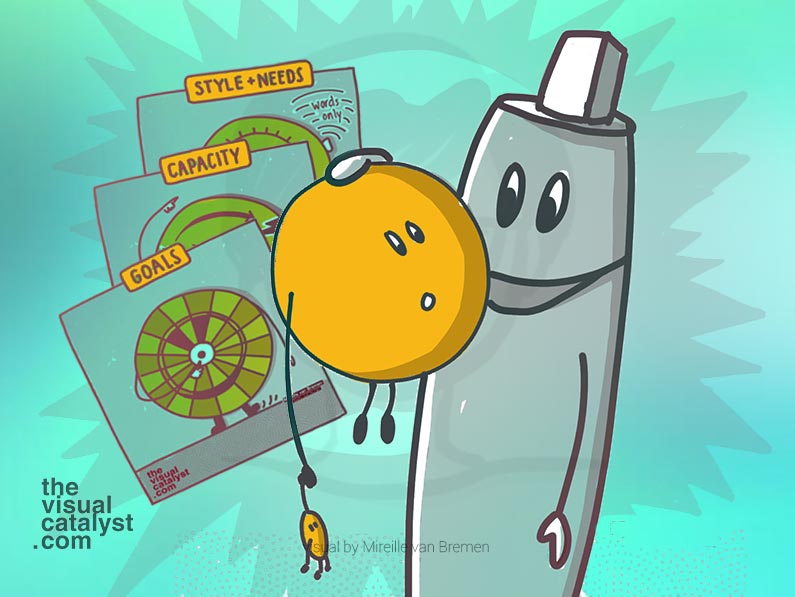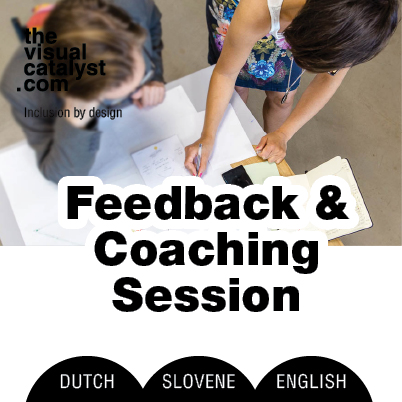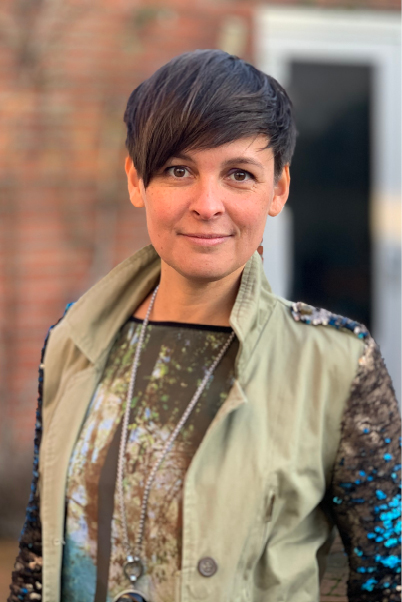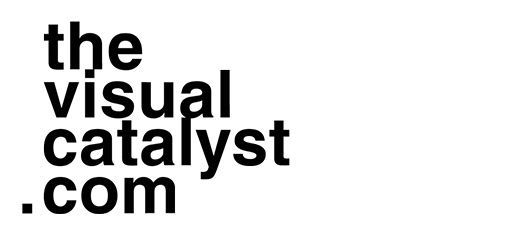
If you don’t know how you personally learn effectively you don’t make the progress you wish to have.
Especially when you are a visual learner and/or practitioner, like a visual facilitator, graphic recorder, designer, illustrator or coach, it is important to be aware of your learning needs because the vast majority of our educational systems does not serve you visually.
Developing your visual skills certainly starts with the decision to learn something and possibly from someone. You must step out of your comfort zone and move into your learning zone. Huh, didn’t I write you don’t learn outside of it? True. But read on, because it’s not what you might think it means. At the end of your learning zone is the freak-out zone. You don’t want to end up there either, because when you feel overwhelmed, anxious and stressed, your emotional response close your system. You are no longer receptive to what you hear, you can’t process or integrate what you hoped to learn.
To develop your visual skills effectively you need to know more about yourself. You need to know how you develop yourself effectively. Some self knowledge is necessary here.
Firstly, when you are naturally curious or consciously choose to learn and develop yourself or your business, it is helpful to reflect from time to time in which zone you find yourself. The aim is to be in the learning zone and if you are not, help yourself get back into the learning zone.
Secondly there are some factors to account and reflect on while you are in the learning zone. Because being there, doesn’t necessarily mean you are learning effectively. Especially when we learn among others, it is easy to forget our learning needs, capacity, abilities and learning style might be different from the majority of the group. You see, educational systems are not only designed very much auditory, they are also designed for the general public. Content is offered in a way that serves lots of people but no one in particular.
Let’s look at three important factors that can immensely affect the impact on your learning results and motivation and joy in the process:
FACTOR 1 – YOU ARE NOT CHALLENGED IN YOUR LEARNING CAPACITY
Although you are learning new skills or developing one you already have, it doesn’t mean you make the progress you were hoping for. Or even worse, you might not be motivated to stay in the practice of learning. Chances are that yes you are out of your comfort zone and into your learning zone, but don’t have sufficient challenge in the learning process or your learning capacity. In other words, your experience is too comfortable, too familiar or easy. If you have a sense you loose motivation over and over again, despite your interest, ask yourself if you are really learning on the edge of your own learning zone or if you are challenged in your capacity to learn. Challenge yourself to move closer towards your freak out zone.
FACTOR 2 – WHAT YOU LEARN DOES NOT CONTRIBUTE TO YOUR GOALS
IWhy do you learn or why do you decide to develop something of yourself or in your business? If you are naturally curious, you might fall in the trap of learning everything and anything that comes on your way. Be picky about why you learn what you learn. This helps you accelerate and move towards the goals you have set for yourself. When you learn, always ask yourself to which of your goals this is contributing. And on top of that, are you learning in general on the topic, or are you learning exactly what you need to know and are you learning from the right people? Be specific and selective!
ISSUE 3 – YOUR LEARNING STYLE AND ABILITIES ARE NOT ACCOUNTED AND YOUR LEARNING NEEDS ARE NOT MET
It doesn’t matter if you participate in a course or if you have created an individual learning environment for yourself. Either way, you are there. You take yourself with you. Your personal learning style, needs and abilities affect the learning process as well as the results. Knowing how you learn best, means you can take this in consideration. If you easily learn through practice rather than theory, make sure you get a lot of kinestethic experience. Reading books about working visually does not make you a visual pracitioner, but spending actual practice time does. If you have difficulties with group dynamics, make sure you learn in small groups or individually, or sit on the side and retreat as much as possible in break times in order to engage less. Do you prefer to integrate the learning through creating and going through your sketchnotes or rather by discussing with a learning buddy? Look for ways that help you have fun and that serve your personally. There is no one way of learning that fits all, but knowing your own way, definitely fits you.
INQUISITIVE QUESTIONS >>> Ask yourself …
QUESTION 1 ⚡️ Am I just learning or am I challenged in my capacity to learn?
QUESTION 2 ⚡️ Does what I learn contribute to my goals?
QUESTION 3 ⚡️ What is my learning capacity, preferred learning style and what are my learning abilities and needs? Are they accounted and my needs being met?
What did you get to know about yourself reading this post?
Please share a reflection in the comments.

Receive feedback on your visual tools & get coached on your visual communication skills.
Gain a big amount of clarity and receive concrete, empowering tips to make modifications that increase your the impact of your communication and visual tools.

My name is MIREILLE VAN BREMEN
I believe that with empathy, clarity and transparency in our communication, we experience and reach more understanding, connection, inclusion, participation, leadership, creativity and trust in our relationships, communities and society.
My clients hire me to design infographics & visual summaries, illustrations and visual tools.
My participants join the online and live communication programs in my Online Training Platform
My programs help to increase impact by communicating both empathically and visually.
